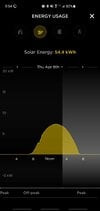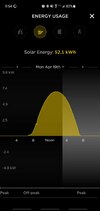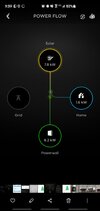I got an email response from my project advisor. Basically it says:
(1) 2 stings are connected in parallel on the roof as designed, acceptable because all panels are located on same azimuth
(2) jumper wire between the two MMPT channels inside inverter is correct
(3) due to not having PTO, production numbers are inaccurate and they do not have production data available for analysis
(4) will reexamine production after PTO
So I will wait.
But in the meantime, let's assume 2 strings of 12 panels in series are connected in parallel. That means at theoretical peak production, the wires coming into the inverter should be 408V 20A. I'm curious as to what the inverter strings 1 and 2 will show after PTO, because as of now it's about 400V at 5A each. Is there like an "unlock" code the inverter receives from Tesla once system is paid for and PTO is granted?





